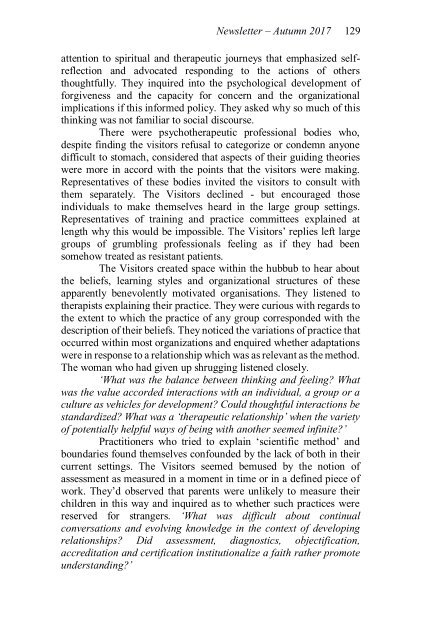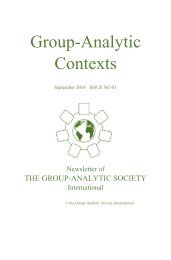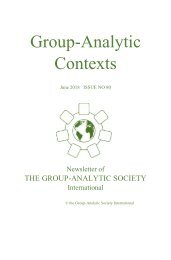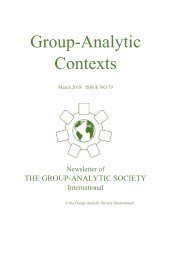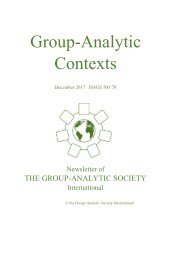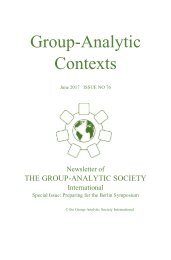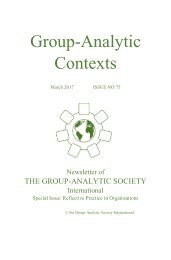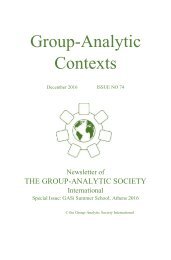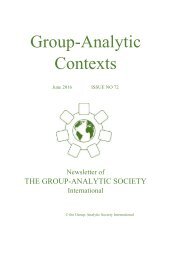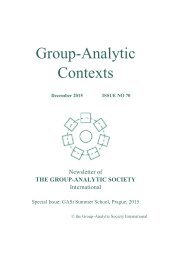Group Analytic Contexts, Issue 77, September 2017
Newsletter of the Group Analytic Society International
Newsletter of the Group Analytic Society International
Create successful ePaper yourself
Turn your PDF publications into a flip-book with our unique Google optimized e-Paper software.
Newsletter – Autumn <strong>2017</strong> 129<br />
attention to spiritual and therapeutic journeys that emphasized selfreflection<br />
and advocated responding to the actions of others<br />
thoughtfully. They inquired into the psychological development of<br />
forgiveness and the capacity for concern and the organizational<br />
implications if this informed policy. They asked why so much of this<br />
thinking was not familiar to social discourse.<br />
There were psychotherapeutic professional bodies who,<br />
despite finding the visitors refusal to categorize or condemn anyone<br />
difficult to stomach, considered that aspects of their guiding theories<br />
were more in accord with the points that the visitors were making.<br />
Representatives of these bodies invited the visitors to consult with<br />
them separately. The Visitors declined - but encouraged those<br />
individuals to make themselves heard in the large group settings.<br />
Representatives of training and practice committees explained at<br />
length why this would be impossible. The Visitors’ replies left large<br />
groups of grumbling professionals feeling as if they had been<br />
somehow treated as resistant patients.<br />
The Visitors created space within the hubbub to hear about<br />
the beliefs, learning styles and organizational structures of these<br />
apparently benevolently motivated organisations. They listened to<br />
therapists explaining their practice. They were curious with regards to<br />
the extent to which the practice of any group corresponded with the<br />
description of their beliefs. They noticed the variations of practice that<br />
occurred within most organizations and enquired whether adaptations<br />
were in response to a relationship which was as relevant as the method.<br />
The woman who had given up shrugging listened closely.<br />
‘What was the balance between thinking and feeling? What<br />
was the value accorded interactions with an individual, a group or a<br />
culture as vehicles for development? Could thoughtful interactions be<br />
standardized? What was a ‘therapeutic relationship’ when the variety<br />
of potentially helpful ways of being with another seemed infinite?’<br />
Practitioners who tried to explain ‘scientific method’ and<br />
boundaries found themselves confounded by the lack of both in their<br />
current settings. The Visitors seemed bemused by the notion of<br />
assessment as measured in a moment in time or in a defined piece of<br />
work. They’d observed that parents were unlikely to measure their<br />
children in this way and inquired as to whether such practices were<br />
reserved for strangers. ‘What was difficult about continual<br />
conversations and evolving knowledge in the context of developing<br />
relationships? Did assessment, diagnostics, objectification,<br />
accreditation and certification institutionalize a faith rather promote<br />
understanding?’


